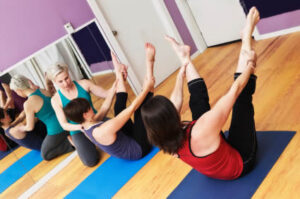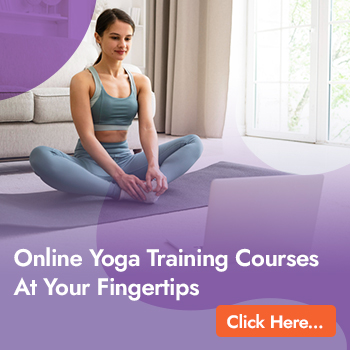
Key Takeaways: Yoga exercises for beginners are essential to building a strong foundation in your practice.
- To start yoga, you only need to learn a few fundamental poses like Mountain Pose and Downward Dog to establish a base for your practice.
- Establishing a regular yoga routine can improve both physical flexibility and mental clarity in as little as 5-15 minutes daily.
- Modifications make yoga accessible to everyone regardless of age, body type, or fitness level.
- Proper alignment is more important than flexibility when beginning yoga, preventing injury and maximizing benefits.
- Peloton’s yoga classes offer guided instruction for beginners with expert cues for proper form and breathing techniques.
Yoga doesn’t require impossible flexibility or years of practice to start reaping its transformative benefits. The journey begins with your very first breath on the mat, and the rewards appear much sooner than you might expect.
Yoga is a practice that has been around for thousands of years. It combines physical postures, breathing techniques, and mindfulness to create a holistic approach to wellness. This makes it accessible to everyone. Whether you are looking to reduce stress, increase flexibility, build strength, or find a moment of calm, a thoughtfully designed beginner yoga routine can be your gateway to these benefits and more. Do Yoga With Me Yoga Classes provide the perfect foundation for beginners. They have expert instructors who guide you through proper form and breathing techniques.
How Yoga Can Change Your Body and Mind
What makes yoga so special is that it is a holistic approach to health. Rather than focusing on individual muscles like many exercises, yoga works the whole body. At the same time, it soothes the mind. Every pose and breath is a step towards uniting the physical and the mental.
Physically, you’ll see improvements in flexibility, muscle strength, balance, and a heightened awareness of your body. The controlled movements and poses you hold in yoga help build functional strength. This supports your daily activities and prevents injuries. Even just 10 minutes of practice a day can make a noticeable difference in how your body feels and moves. For more on starting your journey, check out these yoga exercises for beginners.
6 Essential Yoga Poses Every Beginner Must Know
Building a yoga practice starts with understanding a few fundamental poses. These eight poses form the foundation of most yoga sequences. They provide a well rounded introduction to the practice. Take your time with each one, focusing on proper alignment rather than pushing for flexibility.
Mountain Pose (Tadasana): The Base of All Standing Poses
Although the Mountain Pose might seem easy after all, you’re just standing it imparts the crucial alignment principles that apply to all yoga poses. Stand with your feet hip width apart and your weight evenly distributed. Roll your shoulders back and down, extend your spine, and let your arms hang by your sides with your palms facing forward. This engaged standing pose increases your awareness of your posture while also strengthening your legs and core. Take deep, mindful breaths here, feeling the gentle engagement throughout your entire body.
Downward Facing Dog: The Ultimate Full Body Stretch
The Downward Facing Dog (Adho Mukha Svanasana) is arguably the most recognized yoga pose. It is a gentle inversion where your heart is higher than your head. To do this pose, start on your hands and knees. Then lift your knees off the floor, pushing your hips up and back to form an inverted V-shape with your body. Press firmly through your palms, rotate your upper arms outward, and work to bring your heels toward the floor (it’s okay if they don’t touch it). This pose strengthens your arms and shoulders. It also stretches your hamstrings, calves, and spine.
It’s okay if your heels don’t reach the floor, or if you have to keep your knees a little bent that’s common for beginners. The benefits are derived from the general form and the conscious use of your muscles, not from perfecting the pose.
Child’s Pose: The Go To Resting Pose
Child’s Pose, or Balasana, is your go to resting pose in yoga. It’s a safe space you can always come back to when you need a moment to regroup. To get into Child’s Pose, start by kneeling on your mat with your big toes touching. Spread your knees about hip width apart. Then, sit back on your heels and fold forward, reaching your arms out in front of you and placing your palms flat on the floor. Rest your forehead on the mat and take a few deep breaths. Feel the gentle stretch across your back, shoulders, and hips. This comforting pose is a great way to calm your nervous system. It serves as a reminder that yoga isn’t about pushing yourself to your limits it’s about listening to and respecting your body.
The Warrior I Pose: Developing Strength and Concentration
The Warrior I Pose, also known as Virabhadrasana I, is a symbol of the strength and determination that yoga can help you develop. From the Mountain Pose, take a step back with one foot, keeping a distance of about 3-4 feet between your feet. Turn the foot you stepped back with out at a 45-degree angle. Bend your front knee so that it is directly above your ankle. Keep your back leg strong and straight. Lift your arms over your head, with your palms facing each other, and lift your chest and gaze upward. This is a powerful pose that strengthens your legs, opens your hips and chest, and helps you build mental focus.
Warrior I can be a bit tricky for beginners, especially when it comes to the back heel. Ensure it’s firmly rooted to the ground for stability throughout the pose. If you experience knee pain, adjust the width or depth of your stance until you find a position that’s comfortable and challenging.
Tree Pose: Learning to Balance and Stabilize
Tree Pose, or Vrksasana, is a gentle introduction to balancing postures. Start in Mountain Pose, then move your weight onto your right foot. Position the bottom of your left foot on your right ankle, calf, or inner thigh (but not on the knee joint). Once you feel balanced, either join your hands together at your heart centre or extend your arms over your head like branches. This pose helps to improve focus, strengthen the leg you’re standing on, and open up your hips.
Don’t worry if you lose your balance in Tree Pose, it happens to the best of us! You can use a wall for support or keep your toes on the ground for extra stability. The act of getting back into the pose after you’ve lost your balance is just as important as holding the pose perfectly.
The Corpse Pose (Savasana): It’s All About Final Relaxation
Never miss out on Savasana, the ultimate relaxation pose that helps your body to soak up the benefits of your practice. Position yourself on your back with your legs straight out, your arms slightly away from your sides with your palms facing upwards. Shut your eyes and let your entire body sink into the floor. Although it seems straight forward, Savasana is frequently thought to be the most difficult pose. Because it necessitates total surrender and mental tranquillity.
Take 3-5 minutes to lie in Savasana, even if you’ve only done a short practice. This isn’t just a resting pose. Rather, it’s an active pose where you consciously try to relax while staying alert and aware. The deep relaxation you get from Savasana lowers stress hormones and switches on your body’s healing processes






